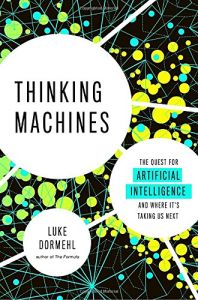Join getAbstract to access the summary!

Join getAbstract to access the summary!
Luke Dormehl
Thinking Machines
The Quest for Artificial Intelligence – and Where It’s Taking Us Next
Perigee, 2017
What's inside?
The explosion of artificial intelligence both empowers and disrupts human aims and values.
Recommendation
In his engaging overview of artificial intelligence (AI), tech journalist Luke Dormehl lucidly sets out the origins of AI, probes its applications and speculates with relish about its wider or wilder potential – for good, ill or some incomprehensible moral hinterland. “Narrow AI” pervades modern life – in wearable devices, smartphones, smart homes, translation apps, digital assistants, and more – while a “wide AI” looms. This presages great benefit – or maybe a “Technological Singularity” that will displace humankind from cognitive dominance.
Summary
About the Author
United Kingdom-based journalist Luke Dormehl‘s previous books include The Formula: How Algorithms Solve All Our Problems…and Create More.

















Comment on this summary